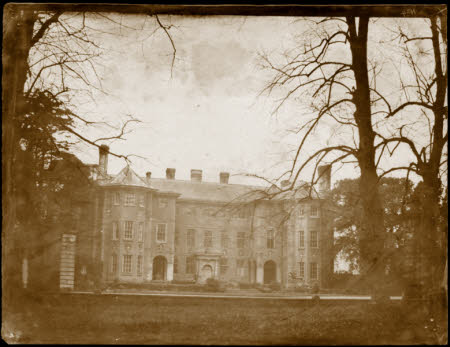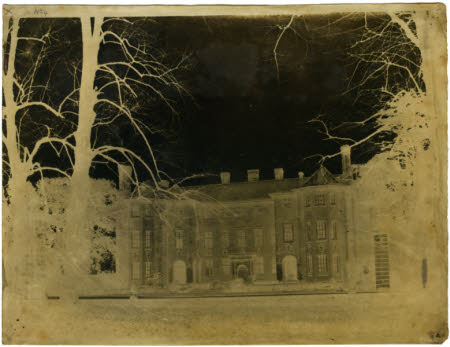Photograph of Ham House
Category
Photographs
Date
circa 1845 - circa 1855
Materials
Waxed paper
Measurements
230 x 300 mm
Order this imageCollection
Ham House, Surrey
NT 2900253
Caption
In January 1839 something extraordinary happened that would forever influence both science and the visual arts. Two men, working quite separately in France and England, discovered the art of photography. Louis Daguerre (1787–1851) in Paris and some days later William Henry Fox Talbot (1800–77) in London announced their invention. Talbot later refined his process, known as calotype, and made several studies of his own house, Lacock Abbey in Wiltshire. The calotype process was slow, requiring several minutes of exposure, so it was better suited to architectural scenes than portraiture. Nonetheless, the technique was enthusiastically adopted by amateur photographers, one of whom took this photograph of Ham House in Richmond upon Thames, Surrey in the mid-19th century. It is a rare wax-paper negative that has been scanned so that a virtual ‘salted paper’ positive can be produced.
Summary
A Calotype waxed paper negative depicting Ham House, dating to c.1845-55. The earliest known photographic image of the house, showing it before the current iron railings on the river side were put up.
Full description
In January 1839, photography was announced on both sides of the channel. First by Louis Daguerre in Paris on 7 January and then eighteen days later, on 25 January by William Henry Fox Talbot in London. Both men had been working independently and without knowing that anyone else was working on the same goal. Two years later Talbot introduced an improved process called the calotype for making negatives on paper from which any number of positive prints can be made. Though not taken up commercially in this country, Talbot's calotype process was quickly adopted by numerous gentlemen amateurs who were drawn to this hybrid of art and science. The calotype process was slow, often requiring several minutes of exposure so it was not suited to portraiture. Instead, these gentlemen often turned their camera on their own houses in the same way that Talbot did. At some point in the late 1840s, Ham House sat for its own portrait. We do not know who the photographer was or much of the provenance of the negative before it came to the National Trust. The weight and quality of the paper indicate it was not by Talbot or one of his close associates. This 'unknown calotypist' was very proficient in this finicky and often difficult process however and made a very fine negative that could have been used for making positive prints. From a scan of this negative we have created a 'virtual' salted paper positive from the negative.
Provenance
Purchased by the National Trust at auction at Dominic Winter, Cirencester, 4 October 2017, lot 412. We are grateful to Matthew Becket for alerting us to the sale of this negative.
References
Sparham 2024: Anna Sparham, 100 Photographs from the Collections of the National Trust, 2024

